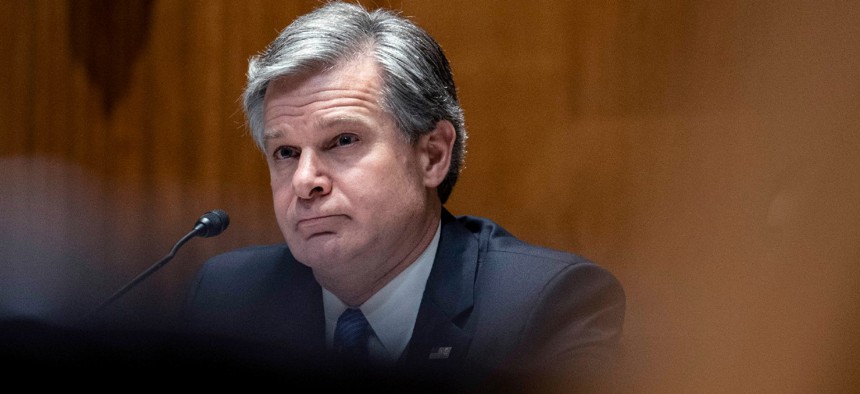
FBI Director Christopher Wray testifies on Capitol Hill in June. Sarah Silbiger/Pool via AP
FBI Agent Used Photos of Young Female Support Staff in Undercover Sex Stings
The images, of staffers not certified to work on undercover investigations, potentially put the women in danger, IG says.
Photos of young female FBI staffers were used in undercover operations for which they were not certified to be involved, potentially putting them in danger, according to a new watchdog alert.
The Justice Department inspector general made public on Monday an eight-page management advisory memorandum, dated July 30, from IG Michael Horowitz to FBI Director Christopher Wray regarding a tactic used in undercover operations by at least one special agent.
“[The Office of Inspector General] learned that [special agents] sometimes used photographs of young female support staff employees to pose as minor children or sex workers to entice sexual predators on various social media websites,” wrote Horowitz in the memo. “These employees were not certified [undercover employees] or certified [online covert employees].”
In the situations the IG reviewed, the employees were clothed and their facies were blurred, but the special agent at the center of the probe “did not document which employees were used, obtain written consent from the employees, document the websites on which the photographs were posted, or document when the photographs were posted,” said the memo. He also didn’t inform the employees' supervisors that their employees were being used in undercover operations and he told the employees to not tell anyone about what was happening.
“FBI had no documentation or information regarding whether the photographs still appear on the websites or how long the photographs appeared on the websites, during which time the photographs could have been—and potentially could still be— downloaded, copied, or further disseminated,” said Horowitz. “The [Office of Inspector General] believes that this conduct poses potential adverse consequences for non- [undercover employees/online covert] employees participating in [undercover] operations, including potentially placing them in danger of becoming the victims of criminal offenses.”
The report does not include specifics about who exactly these special agents were, how many were involved, where they work and when this occurred.
Horowitz said neither the FBI’s undercover policy nor the attorney general’s guidelines on FBI undercover operations address the situation at the center of this investigation. As a result, the IG recommended the FBI establish a policy about using photographs of FBI employees who are not certified for undercover or online covert operations. If the policy allows such employees to be involved, then it should include a management notification and approval process, guidance on the employees’ appearance, and documentation about the use of such photos and written consent from the employees that they are fully informed about the risks of using their photos.
The IG also recommended “other guidelines the FBI deems necessary to ensure photographs of FBI employees for online undercover operations are used safely and appropriately.” The IG asked the FBI to provide a response within 60 days about what actions it’s taking in response to these issues.
Brian Turner, executive assistant director for the FBI’s criminal, cyber, response and services branch, said “the FBI fully accepts these recommendations” in a letter to Horowitz, dated July 27.
“In the coming weeks, the FBI will evaluate existing policy and determine which policies require adjustment, drafting new language to establish the needed guidelines,” wrote Turner. “Upon publication, the FBI will also ensure that the FBI personnel who engage in [undercover] operations are aware of the new guidelines and are trained on the requirements.” Also, the matter involving the special agent who was the subject of the investigation will be adjudicated by the FBI’s Office of Professional Responsibility, he said.







